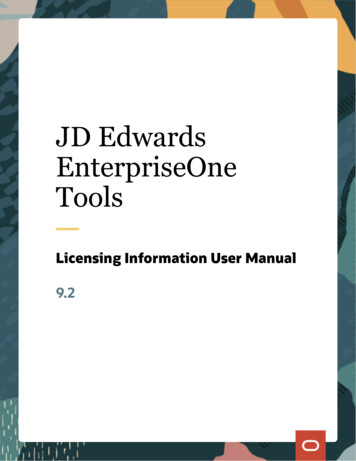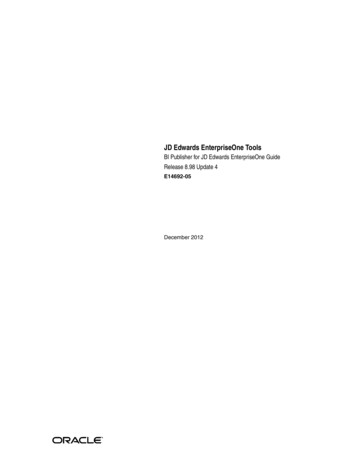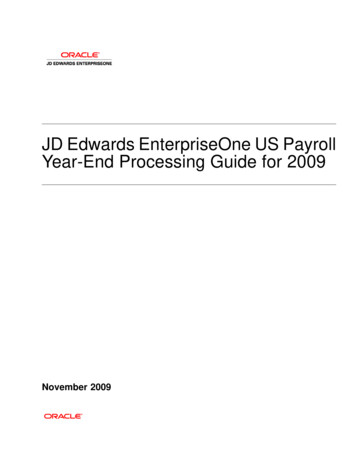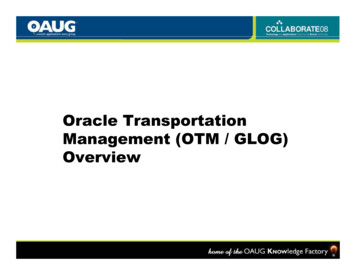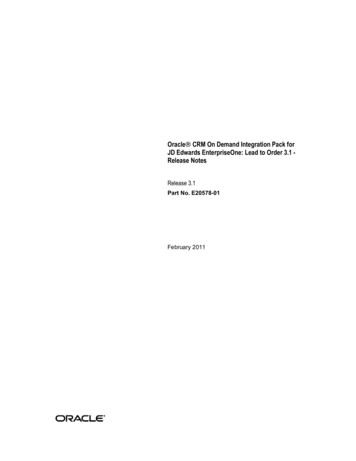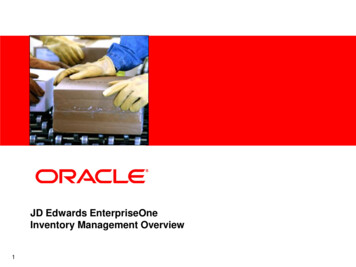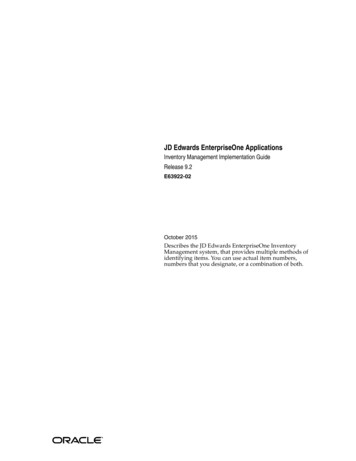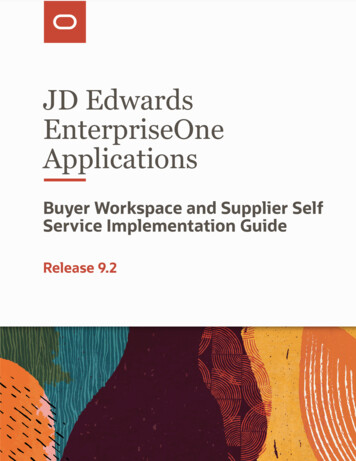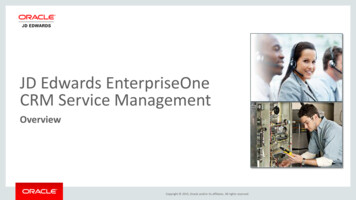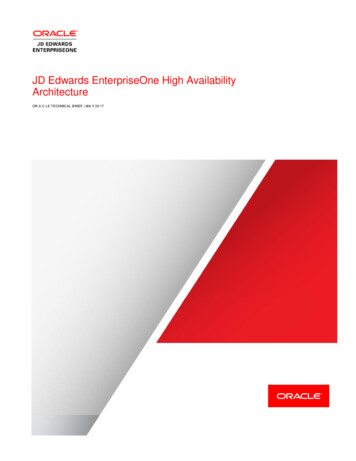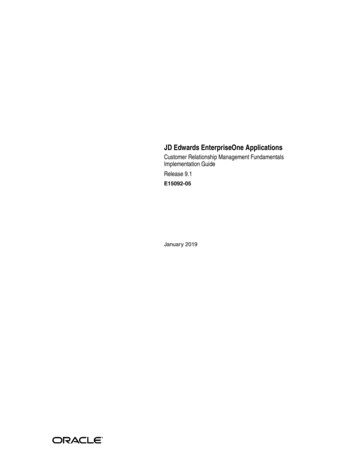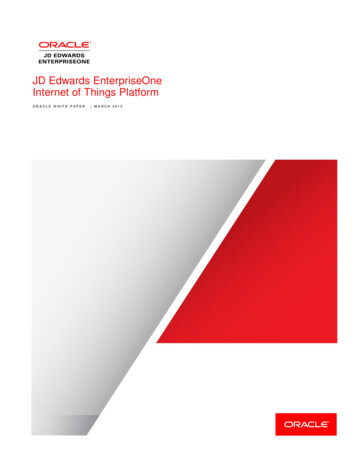
Transcription
JD Edwards EnterpriseOneInternet of Things PlatformORACLE WHITE PAPER MARCH 2015
DisclaimerThe following is intended to outline our general product direction. It is intended for informationpurposes only, and may not be incorporated into any contract. It is not a commitment to deliver anymaterial, code, or functionality, and should not be relied upon in making purchasing decisions. Thedevelopment, release, and timing of any features or functionality described for Oracle’s productsremains at the sole discretion of Oracle.JD EDWARDS ENTERPRISEONE INTERNET OF THINGS PLATFORM
Table of ContentsDisclaimer1Introduction1What is the Internet of Things2Business Value of the Internet of Things2Components of an Internet of Things Solution3Oracle JD Edwards Internet of Things Application Platform4Applications Based on Operational Conditions Metrics5Inventory Management Applications Based on Location Services6Usage, Quality, and Efficiency-Tracking Applications7Oracle Internet of Things Technology Platform8Conclusion and Call to Action9JD EDWARDS ENTERPRISEONE INTERNET OF THINGS PLATFORM
IntroductionOrganizations across the world have been solving problems in the machine-to-machine (M2M) space for years.Collecting information from machines enables organizations to integrate this information into their businessprocesses to make more intelligent decisions, reduce costs, and create new revenue streams.These traditional systems work by attaching sensors to collect information (such as temperature, pressure orvibration) combined with actuators that control the machine. These sensors and actuators are managed by a controlsystem, which in turn communicates back to a central server or operations center for integration into theorganization’s business processes. The problem with these traditional M2M systems is that they are largelyproprietary and inflexible. They require specialized hardware, expensive network connectivity, and high systemintegration expenditure to build the machine information into an enterprise business process. They also lack thesecurity, system management, and analytics capability that organizations require.Oracle JD Edwards has helped thousands of organizations simplify, standardize, and optimize their ERP businessprocesses in the areas of finance, procurement, manufacturing, capital asset management, and supply chain. Thisautomation has resulted in better business decisions, cost savings and increased revenue. Just as this automationhas helped organizations improve their business results, the step of simplifying how M2M information is collectedand acted upon in the context of an organization’s business process will enable organizations to further extend thisvalue to their company assets, manufacturing operations, projects and services, and supply chain.Welcome to the new world of the Internet of Things, where your machines, along with your people and processes,are all connected enabling solutions which were previously not possible.This white paper focuses on how Oracle JD Edwards applications along with Oracle Fusion Middleware can providea working Internet of Things platform which will revolutionize the industrial world by increasing operatingeffectiveness and revenue while at the same time reducing costs and helping to address compliance related needs.The following sections will introduce you to the Internet of Things and suggest how you can start implementing thisexciting technology today to further enhance your organization’s business process:» What is the Internet of Things» Business Value of the Internet of Things» Components of the Internet of Things solution» Oracle JD Edwards Internet of Things Application Platform» Oracle Internet of Technology Platform» Conclusion and Call to Action1 JD EDWARDS ENTERPRISEONE INTERNET OF THINGS PLATFORM
What is the Internet of ThingsThe Internet thus far has primarily been an internet of people who create and consume the data in an interconnectedmanner. The advent of the mobile revolution, however, has created a proliferation of cheap and capablemicroprocessors and networking devices, which, coupled with technological maturity, are ushering in a new age ofMachine-to-Machine Internet. This M2M Internet is characterized by a number of interconnected machines andpeople that is higher by orders of magnitude than traditional internet based solutions. The complete platformcomprised of sensors, network, gateway devices, device identity management, event processing and finally a newclass of smart applications and services is referred to in the technology industry as the Internet of Things (IoT).This interconnected platform where machines and software interact seamlessly promises to bridge the gap betweenthe physical world and the world of software algorithms to bring about disruptive innovation heralding new smartenterprises and ushering in a revolution in modern manufacturing, agribusiness, utilities, energy, mining, real estatemanagement, construction and other industry segments.Business Value of the Internet of ThingsAlmost every organization can benefit from the technology advances described above. For example, where currentlya person is needed to manually inspect a piece of equipment, automation reduces inspection costs, eliminates travelcosts and avoids sending a person into a potentially dangerous location. Automation can help anticipate andtherefore avoid failures to keep projects on schedule and on budget.Currently, many organizations employ machine sensors for data acquisition and supervisory control. However, thenumber and variety of sensors and proprietary protocols which are very limited and rigid in their functionality can bedaunting. The Internet of Things, by contrast, is a seamless appliance based on existing open standards, whichallows you to gain unprecedented operational effectiveness and top-line revenue.Let’s explore some specific business challenges which can be solved with an IoT solution:» Perishable goods – what if you could continuously monitor the temperature, humidity, and location of your goodsas they travel through your supply chain? Monitoring these critical factors and taking quick action on alertsenables you to significantly reduce spoilage and, as a result, increase revenue by reducing costs associated withwasted inventory.» Heavy machinery – what if you could track the location of your company’s equipment along with environmentalconditions and equipment operating conditions? By monitoring these factors, you can ensure that the equipmentis being operated properly, prevent unforeseen machine failures, and ensure that the equipment is being used todeliver your organization’s goods and services.» Product support – what if the products that you sell to your customers could communicate back to yourmaintenance organization the current status, diagnostic information, and available quantity of consumables? Thisinformation will allow you to deliver a better quality of service to your customers by capturing potential failuresbefore they have an impact and also increase your revenue through expanded service offerings andreplenishment of consumables.» Agribusiness – what if you could measure and monitor your entire business process from growing operationsthrough your processing operations as opposed to requiring manual inspection at every step? Thisunprecedented insight into your operations can help you make timely decisions such as irrigation or timelymovement through the manufacturing process.» Unsafe conditions – what if you could monitor the operating environment of a dangerous situation withoutendangering human lives? By monitoring atmosphere, radioactivity, sound, pressure, temperature, etc. usingremote sensors you can ensure the safety of your workers before exposing them to a hazardous workenvironment.2 JD EDWARDS ENTERPRISEONE INTERNET OF THINGS PLATFORM
Thus you can envision a new revolution in the industry allowing your software and hardware assets to work intandem to increase your top line revenue, address regulatory compliance requirements, and reduce your operatingcosts.Figure 1: Business benefits of Internet of ThingsComponents of an Internet of Things SolutionTo successfully deploy an IoT solution, several components are required:» Device or machine equipped with sensors to monitor the device and actuators to control key aspects of thedevice. The device information collected can span location information (such as current location, motion),operational information (such as temperature, humidity, vibration), and usage information (such as machineactivity, production metrics).» Gateway, which collects and processes information from one or more devices, converts the information to aplatform-independent format and communicates this information over the internet. The gateway usually deploysintelligence to filter sensor data, secure data transfer, automate software updating, run diagnostics, start or stopthe device, and support other features.» Network, which is a heterogeneous collection of reliable networking technologies (PAN, LAN, WAN) allowing thegateway to communicate with central servers over the Internet.» Server infrastructure, which filters, stores and aggregates the machine “big” data. The server is capable ofanalyzing and acting upon the data collected.3 JD EDWARDS ENTERPRISEONE INTERNET OF THINGS PLATFORM
» Application business process, which is the key to delivering an end-to-end solution. The application acts on theinformation received by alerting users to required activities and in some cases automatically controlling the devicefor repair or preventative action.Figure 2: Components of an Internet of Things solutionA number of technology advances driven by the proliferation of home networks, smartphones, and enterpriseapplications are enabling this new category of smart applications and services. These advances include:» Low-cost processors for the device and gateway.» Small footprint solutions, including Oracle Java ME, running on the device or gateway.» Low-power circuits which consume very little power and run on battery for extended time periods.» Digital Mesh, Zigbee and other point-to-point communication technology for communicating between device andgateway where no commercial internet or cellular service exists.» Standardized communication protocols and availability of Internet connectivity between the gateway and server,which, while not available everywhere, is very pervasive.Oracle JD Edwards Internet of Things Application PlatformOracle JD Edwards applications, combined with a layered architecture, is uniquely well positioned to leverage thecapabilities of Internet of Things technologies and to offer highly differentiated solutions to its customers. Oracle JDEdwards architecture is based on a unified data model and a metadata-based technology layer which supports acomplete suite of applications. This layered architecture allows the underlying Foundation to leverage newcapabilities which allows for rapid infusion of new technologies and business applications. For example, with theexplosion of mobile smartphone and tablet devices, the applications were easily extended to support these newdevices.This is also true for the delivery of a complete IoT solution.4 JD EDWARDS ENTERPRISEONE INTERNET OF THINGS PLATFORM
Figure 3: Oracle JD Edwards Applications Internet of Things PlatformThe Oracle JD Edwards IoT platform is built on an extension of existing interoperability architecture that is suited foran M2M network. This will provide a familiar modern platform for customers, partners, and other service providersfor integrating the machine information into their existing and new JD Edwards applications. The building blocks ofthis platform are:» Client-side IoT adapters: This component resides on the gateway devices which interface with the machinesensors or PLCs and transport the data to Oracle JD Edwards in an encrypted and secure manner usingstandards-based protocols such as web services or Java message service (JMS) events. This gatewaycomponent provides several utility services to developers to create simple rules for the acquisition, processing,and intended endpoint destination of the data.» JD Edwards server-side components: The highly scalable JD Edwards EnterpriseOne server architecture can bedeployed in a clustered, high-availability configuration which can respond to the highest volume requirements.This server architecture has everything needed to interface either directly with machine sensors or the clientgateway components to process the incoming data, store and analyze the information, and trigger actions in theapplication business processes configured for your industry and user task. This component is transaction-awareand processes the data for urgent notifications, usage patterns, or long term data storage.» JD Edwards applications: This broad set of applications, combined with a high degree of application configurationand extensibility, enables you to extend the capabilities of an existing out-of-the-box suite of applications or createnew processes. In many cases, your JD Edwards applications already have the interface readily available to usesuch as the ability to update a meter reading or automatically create a work order.Potential IoT solutions powered by JD Edwards EnterpriseOne are shown in the following examples:Applications Based on Operational Conditions Metrics» These applications monitor the location and “operating conditions” of the physical entities specified in thebusiness use cases. The operating conditions can include any variety of conditions such as vibration of machines,temperature of shop-floor assets, moisture or humidity in an agricultural container bin, turbidity of water flow, oracoustic patterns denoting the structural integrity of a pipeline. These metrics measure boundary or edgeconditions, usage trends and long-term usage, and trigger work-orders in the Condition-Based Maintenance suiteof applications. The elegance of the solution is that it uses real-time data from equipment monitoring devices toassess equipment conditions against predefined, normal operating parameters.» IoT-enabled Condition-Based Maintenance will enable you to make maintenance decisions based on actualequipment condition, rather than time or usage intervals. You can identify equipment problems early, when they5 JD EDWARDS ENTERPRISEONE INTERNET OF THINGS PLATFORM
are less costly to correct, and perform maintenance only when needed, thereby increasing asset utilization,extending equipment life, and reducing maintenance costs. JD Edwards EnterpriseOne Condition-BasedMaintenance is part of Oracle's JD Edwards EnterpriseOne Asset Lifecycle Management family of applications.» The system provides real-time alerts (via pager, e-mail, or other messaging systems) when equipment isoperating outside of normal bounds to signal the need for appropriate maintenance action, and automaticallyinitiates appropriate maintenance action, including investigation, creation of a work order, and condition-basedmaintenance schedule updates.Figure 4: Applications based on operational conditions metricsInventory Management Applications Based on Location Services» These applications track two types of location information for the targeted assets: Their gross geographicallocation, such as at a job site or the GPS location of a mobile asset, or their fine-tuned spatial location within adefined space, such as a hospital wing or a mine shaft. This set of applications can provide both a historical orpresent location for the asset. This provides an instantaneous insight into inventory tracking and all the relatedassets which are located close to the targeted asset.» IoT-enabled Inventory Management allows for pinpoint accuracy of product quantities and locations and instantaccess to item availability information—both within the facility and throughout the enterprise. You also gain theability to administer consignment sites and vendor-managed inventories from a single database.» Inventory Management offers complete tracking of inventory from the time you receive items from the vendor tothe instant you ship the goods to your customer. Extending your reach beyond the immediate supply chainenables you to also track shipped items for the purpose of returns and warranties. To meet regulatorycompliance, the country of origin can also be tracked at the inventory item level.6 JD EDWARDS ENTERPRISEONE INTERNET OF THINGS PLATFORM
Figure 5: Inventory Management applications based on location servicesUsage, Quality, and Efficiency-Tracking Applications» This functionality provides more advanced insight into the effectiveness of the machines and other operatingassets. The focus of the use cases ranges from an operational “uptime” of machine assets in a plant to moresophisticated quality of end product based on efficiency of the output of shop floor assets spread across hundredsof plants across the world.» The benefits of IoT is that the system can read all of this data coming from the shop floor assets to determinewhich assets are not working efficiently or are in need of preventive maintenance, and automatically create workorders for the problems to be solved.» IoT-enabled JD Edwards EnterpriseOne Quality Management from Oracle provides a consistent, controlledapproach to quality management, helping you identify defects at the source. By incorporating user-definedcheckpoints for key operations, you can verify that items meet standards, tolerances, and design specificationsfrom material receipt to the shipment of the end product. For example, the system could automatically kick offentering a service call when scrap is reported.» Additionally, this functionality allows a customer to determine which action to perform at each stage of production:» Print a certificate of analysis automatically at the time of shipment confirmation that shows the results of alltests performed for a specific lot.» Take advantage of flexible reporting options that allow you to print test results by lot number or work order.» Trace an item’s lot and serial number quickly throughout its entire lifecycle. This purpose is accomplished bykicking off an inventory issue when a serialized component is used.7 JD EDWARDS ENTERPRISEONE INTERNET OF THINGS PLATFORM
Figure 6: Usage, quality, and efficiency-tracking applicationsOracle Internet of Things Technology PlatformThe Oracle JD Edwards IoT platform nests seamlessly within the Oracle IoT platform.Whereas the JD Edwards IoT platform focuses on the application-centric solution, the Oracle IoT platform solveseven the most complex technical and scale challenges.Following the same model as in other areas, customers would use the application-centric JD Edwards solution for asimple, entry-level solution. This approach would enable them to gain IoT capabilities very quickly with very lowTCO.However for complex and very large-scale implementations, one would need to bolster the JD Edwards IoT platformwith one or more components of the Oracle IoT platform such as complex event-processing, device identitymanagement, long-term and high-volume data storage, and big data analysis.Oracle is bringing its vaunted technology middleware to create standards-based middleware solutions in the IoTspace. The technology challenges facing the development of an IoT ecosystem are quite complex and can beeffectively solved only by a company of Oracle’s technical depth and maturity. The challenges and Oracle solutionsinclude:» Common development platform: The sensor chipsets, smart devices, intelligent gateway devices are all based onrapidly evolving hardware technologies. Without common development standards and programming paradigms,the resultant IoT software solutions are very susceptible to being fragmented and incompatible. Oracle is workingwith various leading sensor and gateway manufacturers to provide Oracle’s Java Embedded Technologies.Oracle Java provides the gold standard for device agnostic code portability in M2M environments and taps intothe existing worldwide ecosystem of more than nine million java developers. Using Oracle Java ME Embedded insensor devices and intelligent gateways ensures that software solutions are built in a standards-based mannerwhich is cost-effective, device-agnostic and backed by world-class security and software support.8 JD EDWARDS ENTERPRISEONE INTERNET OF THINGS PLATFORM
» Sensor data event processing: The M2M devices produce a high velocity of data which needs a simple rulesengine to process and sort data. Oracle Event Processing provides a standards-based rules engine for rapid dataprocessing.» Machine data interpretation: The data generated from millions of sensors over thousands of locations can quicklydegenerate into background noise unless it is subjected to rigorous processing, storage, and analysis. Oracleprovides world-class big data solutions for structured and unstructured data via inline database analysis usingOracle Data Miner and Oracle R Engine or Oracle Hadoop Solutions. This allows enterprises to gather actionableinsights over long-term data usage patterns enabling business to make predictions, detect patterns, and findunderlying associations.» Seamless scalability and long-term data storage: Oracle Engineered Systems provide an ideal platform for M2Mdata acquisition and storage. These pre-tested and pre-configured systems provide a cost-effective platform thatsupplies a high degree of reliability, performance, and flexible scalability for growth to meet business demands.PARTNERORACLEINDUSTRYINDUSTRYAPPLICATIONS ERED SYSTEMS,SERVERS & STORAGEFigure 7: Oracle Fusion Middleware Internet of Things PlatformOracle’s engineering teams work seamlessly in providing an end-to-end coverage from creating Java ME platformon edge devices, sensor data event processing, ERP application platform, and data analytics technologies to highlyscalable engineered systems to provide an integrated, scalable and secure platform for IoT Solutions.Conclusion and Call to Action» So, let’s get started with integrating your machines into your business processes. Here is how you can get startedtoday by leveraging:» The JD Edwards IoT platform described in this paper. This is a complete set of server and applicationtechnologies providing a framework that allows very fast development of sensor-to-server connections.» Server-side support from data capture to analysis and reporting and beyond, backed by Oracle’s advancedanalytics, middleware and database solutions.» Partner network with up-to-speed business partners ready to help you further improve your business processesby leveraging IoT technologies.» The familiar and robust JD Edwards technology and application development framework upon which to craft thenew Oracle JD Edwards IoT Applications.To learn more about how you can leverage the Oracle JD Edwards Internet of Things Platform to create gamechanging differentiated business solutions, contact your local Oracle representative or partner.9 JD EDWARDS ENTERPRISEONE INTERNET OF THINGS PLATFORM
Oracle Corporation, World HeadquartersWorldwide Inquiries500 Oracle ParkwayPhone: 1.650.506.7000Redwood Shores, CA 94065, USAFax: 1.650.506.7200CONNECT W ITH ht 2014, Oracle and/or its affiliates. All rights reserved. This document is provided for information purposes only, and thecontents hereof are subject to change without notice. This document is not warranted to be error-free, nor subject to any otherwarranties or conditions, whether expressed orally or implied in law, including implied warranties and conditions of merchantability orfitness for a particular purpose. We specifically disclaim any liability with respect to this document, and no contractual obligations areformed either directly or indirectly by this document. This document may not be reproduced or transmitted in any form or by any means,electronic or mechanical, for any purpose, without our prior written permission.oracle.comOracle and Java are registered trademarks of Oracle and/or its affiliates. Other names may be trademarks of their respective owners.facebook.com/oracleIntel and Intel Xeon are trademarks or registered trademarks of Intel Corporation. All SPARC trademarks are used under license andare trademarks or registered trademarks of SPARC International, Inc. AMD, Opteron, the AMD logo, and the AMD Opteron logo aretrademarks or registered trademarks of Advanced Micro Devices. UNIX is a registered trademark of The Open Group. 0315
Oracle JD Edwards Internet of Things Application Platform Oracle JD Edwards applications, combined with a layered architecture, is uniquely well positioned to leverage the capabilities of Internet of Things technologies and to offer highly differentiated solutions to its customers. Oracle JD
